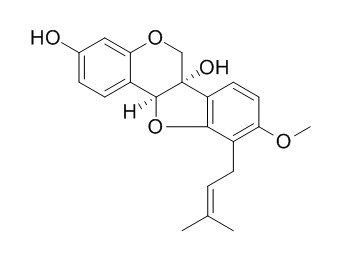Cristacarpin
Cristacarpin exhibits moderate but selective activity towards DNA repair-deficient yeast mutants. It promotes endoplasmic reticulum (ER) stress, leading to sub-lethal reactive oxygen species (ROS) generation and which eventually terminates by triggering senescence in pancreatic and breast cancer cells through blocking the cell cycle in the G1 phase.
Inquire / Order:
manager@chemfaces.com
Technical Inquiries:
service@chemfaces.com
Tel:
+86-27-84237783
Fax:
+86-27-84254680
Address:
1 Building, No. 83, CheCheng Rd., Wuhan Economic and Technological Development Zone, Wuhan, Hubei 430056, PRC
Providing storage is as stated on the product vial and the vial is kept tightly sealed, the product can be stored for up to
24 months(2-8C).
Wherever possible, you should prepare and use solutions on the same day. However, if you need to make up stock solutions in advance, we recommend that you store the solution as aliquots in tightly sealed vials at -20C. Generally, these will be useable for up to two weeks. Before use, and prior to opening the vial we recommend that you allow your product to equilibrate to room temperature for at least 1 hour.
Need more advice on solubility, usage and handling? Please email to: service@chemfaces.com
The packaging of the product may have turned upside down during transportation, resulting in the natural compounds adhering to the neck or cap of the vial. take the vial out of its packaging and gently shake to let the compounds fall to the bottom of the vial. for liquid products, centrifuge at 200-500 RPM to gather the liquid at the bottom of the vial. try to avoid loss or contamination during handling.
Korean J. Medicinal Crop Sci2021, 10:345-352.
J Agric Food Chem.2020, 68(51):15164-15175
Mediators Inflamm. 2016, 2016:6189590
Foods.2023, 12(6):1227.
Food Bioscience2023, 52:102412
Molecules.2022, 27(21):7514.
VNU Journal of Science2023, 39(2):24-33.
Pharmacol Rep.2019, 71(2):289-298
Food Res Int.2021, 148:110607.
The Journal of Korean Medicine2023, 44(4):26-40.
Related and Featured Products
J Nat Prod. 1993 Oct;56(10):1831-4.
Two bioactive pterocarpans from Erythrina burana.[Pubmed:
8277323]
METHODS AND RESULTS:
Bioactivity-directed fractionation of the CHCl3 extract of the bark of Erythrina burana afforded phaseollidin [1] and Cristacarpin [2]. Both 1 and Cristacarpin exhibited moderate but selective activity towards DNA repair-deficient yeast mutants, whereas only 1 was found to be cytotoxic. 13C-nmr spectra of both compounds were assigned.
Age (Dordr). 2016 Jun;38(3):62.
Cristacarpin promotes ER stress-mediated ROS generation leading to premature senescence by activation of p21(waf-1).[Pubmed:
27246693 ]
Stress-induced premature senescence (SIPS) is quite similar to replicative senescence that is committed by cells exposed to various stress conditions viz. ultraviolet radiation (DNA damage), hydrogen peroxide (oxidative stress), chemotherapeutic agents (cytotoxic threat), etc.
METHODS AND RESULTS:
Here, we report that Cristacarpin, a natural product obtained from the stem bark of Erythrina suberosa, promotes endoplasmic reticulum (ER) stress, leading to sub-lethal reactive oxygen species (ROS) generation and which eventually terminates by triggering senescence in pancreatic and breast cancer cells through blocking the cell cycle in the G1 phase. The majority of Cristacarpin-treated cells responded to conventional SA-β-gal stains; showed characteristic p21(waf1) upregulation along with enlarged and flattened morphology; and increased volume, granularity, and formation of heterochromatin foci-all of these features are the hallmarks of senescence. Inhibition of ROS generation by N-acetyl-L-cysteine (NAC) significantly reduced the expression of p21(waf1), confirming that the modulation in p21(waf1) by anti-proliferative Cristacarpin was ROS dependent. Further, the elevation in p21(waf1) expression in PANC-1 and MCF-7 cells was consistent with the decrease in the expression of Cdk-2 and cyclinD1.
CONCLUSIONS:
Here, we provide evidence that Cristacarpin promotes senescence in a p53-independent manner. Moreover, Cristacarpin treatment induced p38MAPK, indicating the ROS-dependent activation of the MAP kinase pathway, and thus abrogates the tumor growth in mouse allograft tumor model.
Nat Prod Res. 2009;23(12):1089-94.
Three new isoflavanones from Erythrina costaricensis.[Pubmed:
19662573]
METHODS AND RESULTS:
Three new isoflavanones, 5,7,3'-trihydroxy-4'-methoxy-6,5'-di(gamma, gamma-dimethylallyl)-isoflavanone (1), 5,3'-dihydroxy-4'-methoxy-5'-gamma,gamma-dimethylallyl-2'',2''-dimethylpyrano[5,6 : 6,7]isoflavanone (2) and 5,3'-dihydroxy-2'',2''-dimethylpyrano[5,6 : 6,7]-2''',2'''-dimethylpyrano[5,6 : 5,4]isoflavanone (3), along with two known isoflavonoids, Cristacarpin and euchrenone b(10), were isolated from the stems of Erythrina costaricensis. Their structures were established on the basis of spectroscopic evidence.
CONCLUSIONS:
Compound 3 is a rare isoflavanone possessing two 2,2-dimethylpyran moieties. Among the new isoflavanones, compound 1 showed potent antibacterial activity against methicillin-resistant Staphylococcus aureus.



